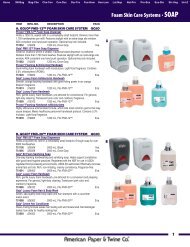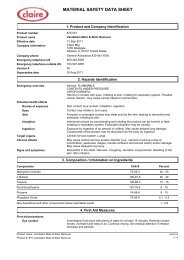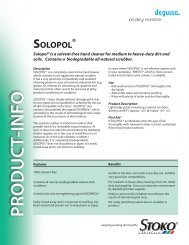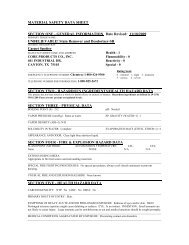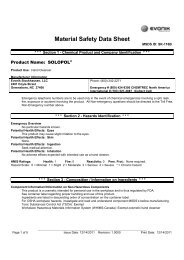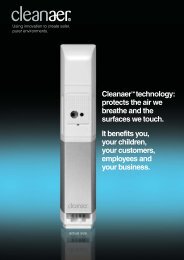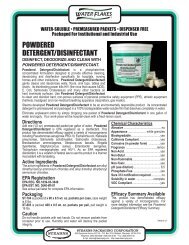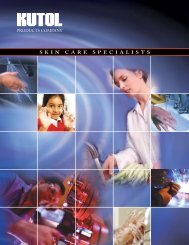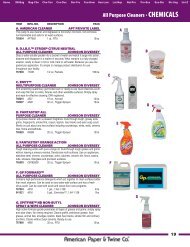What's New Newsletter? - Myers Supply & Chemical
What's New Newsletter? - Myers Supply & Chemical
What's New Newsletter? - Myers Supply & Chemical
Create successful ePaper yourself
Turn your PDF publications into a flip-book with our unique Google optimized e-Paper software.
<strong>What's</strong> <strong>New</strong> <strong>New</strong>sletter?<br />
Low Moisture Carpet Cleaning System<br />
Low-moisture cleaning, more than any other type of carpet maintenance, results in<br />
carpet that looks uniform, consistent and clean. Also, because it uses less water than<br />
restorative cleaning, low-moisture cleaning leaves carpet drier after cleaning and<br />
therefore, allows carpet to remain consistently in use. These are significant benefits<br />
both to building managers who want clean looking carpets that are open to foot<br />
traffic and to cleaning professionals who desire unrestricted cleaning.<br />
Crystal Clean<br />
A revolutionary solution for maintaining today’s<br />
carpeting. Crystal Clean incorporates our premium<br />
anti-resoiling technology, which encapsulates soil<br />
and dries to a non-sticky crystal. Soil and residue<br />
then vacuum out easily!<br />
This low moisture process formula eliminates the need<br />
for rinsing and minimizes carpet downtime. Stops discoloration<br />
problems caused by wicking. Crystal Clean<br />
also contains an effective malodor counteractant and a<br />
universal fresh fragrance.<br />
20" Carpet Blazer<br />
Designed for ease of use and the highest performance in<br />
Low-Moisture Carpet Encapsulation Maintenance. The<br />
Carpet Blazer Encapsulation Machine covers up to 5,000<br />
square feet per hour with little effort. It’s 20” orbital head is<br />
powered by a 1 HP motor, which floats it’s 120# weight<br />
over low-nap commercial carpeting effortlessly.<br />
Its Orbital Head Action creates just the right mechanical agitation<br />
to break soils loose while avoiding stretching or damaging<br />
carpets. The 50’ commercial cord and high<br />
capacity solution tank makes continuous operation over large<br />
areas easy to achieve. Carpets are clean and ready for use in<br />
as little as 30 minutes.<br />
Microfiber Carpet Bonnet<br />
The ultra microfiber bonnet with scrub stripes adds additional<br />
scrubbing action improved cleaning performance. The microfiber<br />
flexes and grabs the dirt and traps it in the fibers. They can<br />
be used with the Carpet Blazer or any standard rotary floor<br />
machine to pull dirt and soil out of carpet.<br />
<strong>Myers</strong> <strong>Chemical</strong> & Supplies<br />
Get more product info at: www.<strong>Myers</strong><strong>Supply</strong>.com<br />
<strong>Myers</strong><strong>Supply</strong>.com<br />
<strong>Myers</strong> <strong>Supply</strong><br />
900 Arch St. Little Rock, AR 72202<br />
501-372-6677<br />
831 Third St. Hot Springs, AR 71913<br />
501-623-7742<br />
www.<strong>Myers</strong><strong>Supply</strong>.com<br />
<strong>New</strong>sletter Date 01/07/08 , Issue 39<br />
Did You Know?<br />
• An average of only 1 in 6 people<br />
wash their hands after using the<br />
restroom.<br />
• After using the restroom, a single<br />
hand can have a population count<br />
of more than 200 million bacteria<br />
per square inch.<br />
• When you sneeze, germs can<br />
travel at 80 miles per hour across<br />
a room.<br />
• One microbe can grow to become<br />
more than 8 million germs in just<br />
one day.<br />
• A kitchen cutting board harbors<br />
50 times more bacteria than your<br />
toilet seat.<br />
• The average desk harbors 400<br />
times more bacteria than the<br />
average toilet seat.<br />
• Viruses can survive on common<br />
surfaces like faucet handles for<br />
up to 72 hours.<br />
• The majority of food-poisoning<br />
cases are acquired in the home.<br />
• The average child catches at least<br />
8 colds in a year, and U.S. kids<br />
miss as many as 189 million<br />
school days each year due to<br />
colds.
Page 2<br />
Corn + Water + Paper = A Revolutionary Eco-Friendly Cup<br />
Consider this . . .<br />
Our new Ecotainer Paper Cup is made from renewable resources and is 100% compostable and<br />
petroleum free, making this cup very earth-friendly! These compostable hot cups are perfect for greening<br />
your coffee shop or office. Compostable in a commercial composting environment, the Ecotainer<br />
Cup has an inner lining made from 100% corn, whereas conventional paper cups have inner linings<br />
made from petroleum. Also, the paper comes from trees that were harvested sustainably, and the cups<br />
are chlorine-free!<br />
These cups perform the same or better than regular paper hot cold cups.<br />
Every year, Americans drink more than 100 billion cups of coffee. Of those, 14.4 billion are served in disposable paper<br />
cups— enough to wrap the earth 55 times if placed end-to-end! Those paper cups contain a plastic lining made from a<br />
petrochemical that would produce enough energy to heat 8,300 homes. That’s a town the size of Searcy, Arkansas.<br />
Eco-Friendly Biodegradable Cutlery<br />
Say goodbye to plastic cutlery and hello to SpudWare cutlery made from 80% potato starch<br />
and 20% soy oil that’s just as heat resistant and every bit as strong as plastic cutlery. The<br />
kicker? It biodegrades in just 180 days! SpudWare can even be washed and reused, so you<br />
can eat your potatoes with potatoes for months to come.<br />
Help save the environment with this high quality line of cutlery. Good for to-go meals, picnics,<br />
or when you just want to sit down at home with a bowl of soup. The environment will<br />
thank you -- and you will thank yourself -- for using this wonderful product.<br />
Each year, 40 billion polystyrene utensils are thrown into landfills across the country. Using<br />
biodegradables allows you to divert your "disposables" to the compost heap, saving you<br />
money on waste collection costs, and saving the planet from excess waste.<br />
This cutlery passes all recognized tests of biodegradability and is also compostable. It is the<br />
best biodegradable cutlery on the market for hot soups or chili.<br />
Eco-Friendly Biodegradable Tableware<br />
Bagasse is sugar cane fiber pulp, left after the juice has been extracted from the<br />
sugar cane stalk. Bagasse is normally seen as a waste product, and is often burned<br />
thereby causing air pollution. Making tableware out of the sugar cane pulp solves<br />
the problem of waste and as well creates a value added product from a material,<br />
which is treated as a waste product.<br />
Sugar cane fiber bagasse tableware is made by pressing the pulp at high pressure and temperatures to a mold form. It is<br />
sterilized and sanitized, conforms to US Food & Drug Administration guidelines.<br />
Bagasse is 100% compostable and it biodegrades in 30-90 days. Through the use of this<br />
product, you are contributing to a sustainable planet. Bagasse is a tree-free readily<br />
renewable resource and provides a superior alternative to petroleum derived products.<br />
It will bio-degrade and will not stay in the environment for hundreds of years.<br />
Bagasse tableware will handle hot food and beverages up to 190 degrees Fahrenheit.<br />
Bagasse is both microwave and freezer safe.<br />
<strong>Myers</strong><strong>Supply</strong>.com
Page 3<br />
POP & SHINE RTU<br />
Pop & Shine Ready-To-Use Gloss Restorer is a revolutionary product that renovates floor finish and restores<br />
floors to maximum gloss…like magic! Now it is available in a convenient, Ready-to-use package<br />
that is easy to use, easy to store. No complicated mixing or dilution required, the perfect concentration<br />
every time. Specially selected polishing agents and cleaners help to remove scratches and scuffs from<br />
floors while rejuvenating the floor to a brilliant lustre. Saves labor; extends scrub / strip cycles. A must<br />
for every high speed / UHS Burnishing Floor Care program!<br />
PRODUCT FEATURES / BENEFITS<br />
• Ready-to-use / Save time and labor, highly accurate ready-to use dilution.<br />
• Fast and Easily / Creates a bright, shiny, wet look gloss<br />
• Ideal for Multi Speed Polishing and Burnishing<br />
• Fast drying for added labor savings<br />
• Repeated applications removes deep scuffs and scratches<br />
NU-LOOK<br />
NU-Look Wood Floor Cleaner/Conditioner is a neutral range pH formula that cleans and conditions<br />
wood floors to restore their natural beauty and luster. NU-LOOK uses specially selected,<br />
naturally derived ingredients to gently remove soils from the wood surface.<br />
Regular use of NU-LOOK creates a dirt resistant barrier and makes wood surfaces more<br />
resistant to water damage. Regular use of NU-LOOK brings out the natural color and beauty<br />
of wood floors while it improves slip resistance. NU-LOOK is pleasantly scented to deodorize<br />
as it cleans!<br />
PRODUCT FEATURES / BENEFITS<br />
• Restores natural beauty and luster of wood surfaces<br />
• Creates dirt resistant barrier<br />
• Improves resistance to water stains<br />
• Improves slip resistance of wood floors<br />
ISSA & OSHA Cooperate on <strong>New</strong> Cleaning Industry Web Page<br />
A new OSHA web page, developed with the support and assistance of ISSA, will help employers in the cleaning industry<br />
protect the safety and health of their most valuable asset, their employees.<br />
The new Safety and Health Topics page, “OSHA Assistance for the Cleaning Industry,” provides<br />
information on potential hazards, such as slips, trips and falls, and bloodborne pathogens, as well<br />
as information on OSHA standards, and links to free resources from both OSHA and ISSA. The web page is a product of<br />
the ISSA and OSHA Alliance. www.osha.gov/dcsp/products/topics/cleaningindustry/index.html<br />
“Through the Alliance with OSHA, ISSA has positioned itself as the leading resource on safety and health issues for employers<br />
and employees in the cleaning industry,” according to Bill Balek, ISSA Director of Legislative Affairs. “This new<br />
Safety and Health Topics page is yet another example of ISSA’s commitment to assist employers and their workers in identifying<br />
and preventing workplace hazards in the cleaning industry.”<br />
ISSA and OSHA established a formal Alliance in August 2005 to enhance the safety and health of<br />
workers throughout the cleaning industry. Under the auspices of the Alliance, ISSA and OSHA<br />
have worked together to communicate to the cleaning industry ways they can improve the safety<br />
and health of their employees and otherwise protect them from workplace hazards.<br />
For over two years, ISSA and OSHA have worked together under the Alliance, providing more than 77,000 ISSA members<br />
and others in the cleaning industry with valuable information and training resources. One of the many tools produced under<br />
this Alliance is the ISSA Safety and Health Portal, a one-of-a-kind Web network dedicated exclusively to the protection of<br />
the health and safety of workers in the cleaning industry. The site at www.issa.com/osha offers five topic pages focusing<br />
on: Exposure to Bloodborne Pathogens; Cleaning <strong>Chemical</strong>s in the Workplace (Hazard Communication); Injury & Illness<br />
Recordkeeping; Personal Protective Equipment (PPE); and Slips, Trips and Falls in the Workplace.<br />
<strong>Myers</strong><strong>Supply</strong>.com
Page 4 <strong>What's</strong> <strong>New</strong> <strong>New</strong>sletter?<br />
CDC and NIOSH Issue MRSA Guideline<br />
The Centers for Disease Control (CDC) and the U.S. National Institute for Safety and Health (NIOSH) have both issued<br />
guidelines intended to prevent the spread of MRSA in schools and the workplace respectively. Both the CDC and NIOSH<br />
guidelines emphasize good hygiene and housekeeping practices as essential in preventing MRSA infections.<br />
Methicillin-resistant Staphylococcus aureus (MRSA) is a group of staphylococcus bacteria that have developed resistance<br />
to several antibiotics, including methicillin. Most staph infections, including MRSA, occur among health care facility patients<br />
with weakened immune systems. However, CDC and NIOSH noted in their respective guidelines that staphylococcus<br />
and MRSA infections can also occur in otherwise healthy people.<br />
Prevention of the Transimission of MRSA<br />
In their respective guidelines, both the CDC and NIOSH noted the following as critical elements in preventing the<br />
transmission of MRSA in the workplace and in schools:<br />
• Cleaning and disinfection should be performed on surfaces that are likely to contact uncovered or poorly covered skin<br />
infections.<br />
• Cleaning surfaces with detergent based cleaners or EPA registered disinfectants is effective at removing MRSA from<br />
the environment.<br />
• Ensure that routine housekeeping procedures are conducted.<br />
• Encourage students and workers to practice good hygiene that includes thoroughly washing hands, keeping cuts clean<br />
and covered, avoiding contact with other people’s wounds or bandages, and not sharing personal items such as towels<br />
and uniforms.<br />
Availability of MRSA Guidelines<br />
To access the NIOSH Guidelines on MRSA and the Workplace go to:<br />
http://www.cdc.gov/niosh/topics/mrsa/<br />
To access the CDC Guidelines on the subject of MRSA in schools go to:<br />
http://www.cdc.gov/Features/MRSAinSchools/<br />
In addition, The U.S. Environmental Protection Agency (EPA) provides a list of EPA-registered<br />
disinfectants that are effective against MRSA go to:<br />
http://www.epa.gov/oppad001/chemregindex.htm<br />
Please note that in regard to the EPA list of MRSA effective products, only primary<br />
product names from the primary registrants are included.<br />
<strong>Myers</strong><strong>Supply</strong>.com
Page 5 <strong>What's</strong> <strong>New</strong> <strong>New</strong>sletter?<br />
Emerging Staph Strains Found to be<br />
Increasingly Deadly and Deceptive<br />
A study of how the immune system reacts to strains of antibiotic-resistant Staphylococcus aureus bacteria — emerging<br />
strains that sicken otherwise healthy people, or so-called “community-acquired” infections — has shown for the first time<br />
that these strains are more deadly and better at evading human immune defenses than more common S. aureus strains that<br />
originate in hospitals and other healthcare settings.<br />
In a paper released today online in The Journal of Immunology, scientists from the National Institute of<br />
Allergy and Infectious Diseases (NIAID), part of the National Institutes of Health, describe how community<br />
-acquired S. aureus strains that survive treatment with the methicillin family of antibiotics can evade<br />
immune defenses. Infections from community-acquired methicillin-resistant S. aureus, or MRSA, are<br />
difficult to treat and are increasing nationally at an alarming rate, say experts.<br />
Scientists at NIAID’s Rocky Mountain Laboratories (RML) in Hamilton, Mont., and colleagues examined the ability of<br />
MRSA strains to cause disease in mice and avoid destruction by human white blood cells called neutrophils. Neutrophils,<br />
which typically ingest and then kill harmful bacteria, make up about 60 percent of all white blood cells and are the first line<br />
of defense against bacteria. Scientists know that community-acquired strains differ from hospital strains, but they don’t<br />
know why the community strains cause more serious infection in otherwise healthy people.<br />
The work also identified specific S. aureus genes that potentially control the bacterium’s escape from neutrophils. Among<br />
thousands of S. aureus genes analyzed in the five different strains used in the study, the scientists identified a large group of<br />
genes whose role in helping spread infection is unknown. RML’s Frank DeLeo, PhD, the investigator who directed the<br />
study, and colleagues plan to determine if some of the unknown genes help promote disease. If they can learn which genes<br />
control the ability of S. aureus to evade and destroy neutrophils, their work could lead to new medical treatments.<br />
“Each day physicians around the world are stymied by the inability to effectively treat patients suffering<br />
from severe S. aureus infections,” says NIAID director Anthony S. Fauci, MD. “There is a critical need to<br />
develop new treatments against late-stage disease caused by antibiotic-resistant strains, and this promising<br />
work offers several new approaches.”<br />
According to the Centers for Disease Control and Prevention (CDC), “recent reports of community-acquired<br />
MRSA infections raise concern … If MRSA becomes the most common form of Staphylococcus aureus in a community, it<br />
will make treatment of common infections much more difficult.” The April 7, 2005, issue of The <strong>New</strong> England Journal of<br />
Medicine refers in an editorial to “… an epidemic of MRSA in the community.”<br />
S. aureus strains acquired in healthcare settings can be challenging to resolve because of antibiotic resistance, which limits<br />
the choices for treatment. But the situation can become more serious with the newer community-acquired strains, says<br />
DeLeo. “We do not know why cases of community-acquired MRSA infections are increasing, let alone how they flourish,”<br />
he says. But scientists do know the community strains can cause more severe forms of disease.<br />
Mild S. aureus infections such as impetigo, which typically forms small blisters on the faces of children, or<br />
cellulitis, an inflammation of skin or muscle tissue, can easily be treated and usually resolve in a matter of<br />
days. But S. aureus disease also can be much more severe and difficult to treat, affecting vital organs and<br />
leading to toxins poisoning the blood and infection overwhelming the heart. One of the most severe types of<br />
disease is necrotizing pneumonia, where bacteria destroy lung tissue.<br />
“The reason that some mild infections become severe or fatal is not well understood, but virulence is often associated with<br />
certain strains,” says Jovanka Voyich, PhD, of RML, the study’s lead author. To cause human disease, bacterial pathogens<br />
must avoid being killed by neutrophils. “These results,” says Voyich, “suggest that community-acquired MRSA causes<br />
disease in healthy people in part because it has enhanced ability to circumvent killing by neutrophils.”<br />
Reference: J Voyich et al. Insights into mechanisms used by Staphylococcus aureus to avoid destruction by human<br />
neutrophils. The Journal of Immunology 175(6):3907-19 (2005).<br />
Source: National Institutes of Health<br />
<strong>Myers</strong><strong>Supply</strong>.com
Page 6 <strong>What's</strong> <strong>New</strong> <strong>New</strong>sletter?<br />
Where do germs hide?<br />
There are trillions of germs everywhere people live, work, and play! Keeping your family safe from harmful germs and the<br />
illness they can cause is of utmost importance to today's busy workers, parents, teachers and anyone else who wants to stay<br />
healthy.<br />
Restrooms<br />
One of the public places most associated with germs are public restrooms, and with good reason. According to a study<br />
conducted by researchers at the University of Arizona, the most common microorganisms associated with outbreaks<br />
stemming from public restrooms include shigella, salmonella, norovirus, and hepatitis A virus.<br />
Bacteria and viruses are ejected and aerosolized when the toilet is flushed, and these germ-filled<br />
droplets land on all surfaces in the restroom, contaminating the environment with infectious microorganisms.<br />
Researchers found that 64 percent of the time, the floor in front of the toilet in a public<br />
restroom was contaminated with coliform (fecal) bacteria, while 61 percent of the time for sinks, 20<br />
percent of the time for the top of the toilet, 15 percent for the sink faucet, and 6 percent of the time<br />
for the toilet handle.<br />
According to the researchers, women’s restrooms were significantly more contaminated than men’s restrooms; the middle<br />
stall was the most often more contaminated than others, and that airport restrooms were the germiest restrooms of all. The<br />
alarming thing is that 95 percent of people report that they wash their hands after using a public restroom, but only 67<br />
percent actually wash their hands; only 33 percent actually use soap, and just 16 percent wash their hands for the prescribed<br />
duration of 15 to 20 seconds. To safeguard against infection, experts advise people to wash their hands thoroughly<br />
with soap and warm water after using public restrooms.<br />
Did you know that according to a recent study conducted by researchers at the University of Arizona, the bathroom sink is<br />
the third germiest location in the average house? The study also revealed that the bathroom floor, bathroom counter, and<br />
toilet seat are the No. 6, 7, and 8 (respectively) germiest places in the rest of the house. The bathroom can frequently be<br />
one of the germ-filled places in the house, so careful attention to regular cleaning and disinfection is crucial, especially if<br />
someone in the household has a highly contagious stomach-related illness, a cold, or the flu.<br />
A piece of advice from the experts: Close the toilet lid before you flush to keep microbes inside the bowl from splashing<br />
as far as 20 feet onto you, counters, and anything on them! And a word about cleaning the bathroom: Cleaning and disinfecting<br />
are not the same thing. Cleaning removes germs from surfaces, while disinfecting actually destroys them. Cleaning<br />
with soap and water to remove dirt and most of the germs is usually enough, but sometimes you may want to disinfect for<br />
an extra level of protection from germs. While surfaces may look clean, many infectious germs may be lurking around. In<br />
some instances, germs can live on surfaces for hours or even for days. Disinfect those areas where there can be large<br />
numbers of germs and where there is a possibility that these germs could be spread to others; these are the high-touch areas<br />
such as sink faucets, toilet handles, and door handles. When cleaning surfaces, don’t let germs hang around on cleaning<br />
cloths or towels; use either paper towels that can be thrown away, cloth towels that are later washed in hot water with<br />
detergent, or disposable sanitizing wipes that both clean and disinfect.<br />
Office Environment<br />
Did you know that according to a recent study by researchers at the University of Arizona, the phone<br />
is the No. 1 germiest item in a typical office environment, followed (in decreasing order) by the desktop,<br />
the keyboard, the mouse, the fax machine, the photocopier, and interestingly enough, in last place<br />
is the toilet seat. Parenthetically, the average toilet seat has just 49 germs per square inch.<br />
According to a study conducted by researchers at the University of Arizona, a lawyer’s desk averages 900 bacteria per<br />
square inch, which is less than a teacher’s desk, which harbors as many as 17,000 bacteria per square inch. The average<br />
desk worker's telephone had about 25,000 germs per square inch, according to the same study. The study found that on<br />
average, every 60 seconds, a working adult touches as many as 30 objects. The study advises office workers to regularly<br />
wipe down the desktop, phone, and keyboard with disinfectant wipes or use a spray disinfectant designed for hard surfaces.<br />
<strong>Myers</strong> <strong>Chemical</strong> & Supplies<br />
Get more product info at: www.<strong>Myers</strong><strong>Supply</strong>.com<br />
<strong>Myers</strong><strong>Supply</strong>.com



